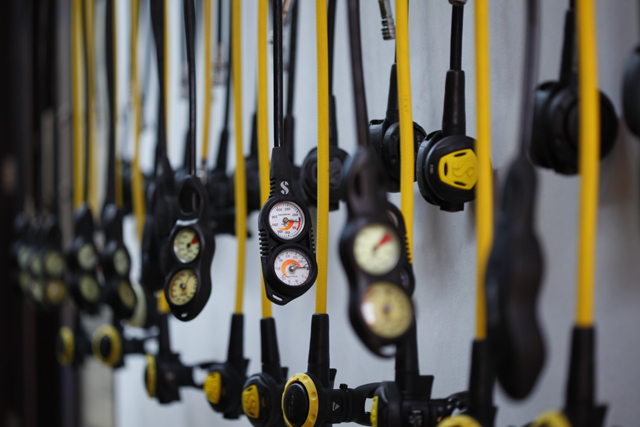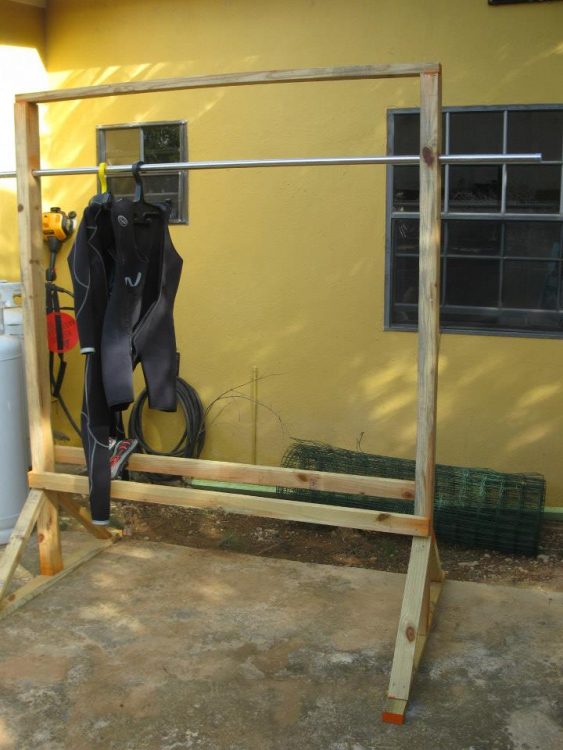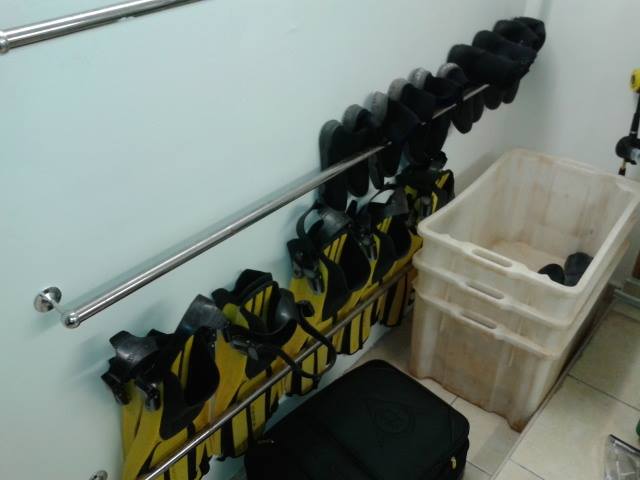Here is How You Should Take Care of Your Scuba Dive Equipment
Taking proper care of your scuba diving equipment is imperative after each and every dive if you want to keep your gear in great shape for years to come.
And by maintaining your scuba gear, you’ll be reducing the odds of equipment failure during a dive that would lead to an emergency situation underwater.
Basic protocol involves rinsing off all of your gear with fresh water and then putting the gear in a safe place where it can dry off thoroughly prior to packing it away.
Never leave your equipment in direct sunlight over long periods because sunlight will cause materials to crack, fade, and degrade, and this includes rubber and neoprene.
To learn more about how to take care of various pieces of your diving gear, continue reading…
How to Take Care of Your BCD
Thoroughly wash off your BCD, start by rinsing off the exterior with fresh water before handling the inside.
Salt water will leak into your BCD during a dive via its low-pressure inflator and its dump valves, so don’t neglect cleaning out the interior too.
Drain out all of the water by using a hose. Flush as much fresh water into the bladder of the BCD through the low-pressure inflator as possible.
Hold the deflate button as you flush the water into it, allowing the fresh water to get into your BCD until it has become about ¼ of the way full.
Orally inflate it to let the water circulate throughout the inside of the gear. Shake it to be certain the water can get to every single part of the jacket, and then let the water drain through the BCD dump valves, thoroughly rinsing them off.
Repeat the process a few times. Then inflate your BCD only partially before storing it, as this will effectively prevent the inside pieces from getting stuck together. Keep it hanging in a dry, cool place.
Feel free to check out our following Scuba Dive partners anywhere in the world for packages, training or guided trips:
How to Take Care of Your Scuba Tank?
It’s important that you don’t forget about your scuba tank during your post-dive cleaning routine.
It, too, will need to be thoroughly rinsed using fresh water. The purpose of doing this is to prevent any salt from building up in the cylinder and causing corrosion.
This process also gets rid of any sand and grit that has got stuck on the tank valve, as it can eventually make it harder to turn the air off and on.
Don’t store your cylinder when it’s either full of empty. The lack of pressure while it’s empty will make it easy for contamination to occur.
And if the cylinder is stored when full, it can eventually lead to cracks. Also, store your cylinder in a secure upright position or lying down horizontally.
How to Take Proper Care of Your Regulator?
As you probably guessed, your regulator will also need to be thoroughly rinsed off using fresh water after your day of scuba diving is complete.
Just be certain that you don’t get any water into the gear’s first stage. The internal parts are vulnerable to damage when they’re exposed to water and moisture, so letting them get soaked will probably end up causing you to have to take your regulator to a professional to get fixed.
Prior to rinsing off your regulator, replace the dust cap, securely fastening it on. Of course, make sure the cap is dry first.
Use compressed air that you could get from the cylinder in order to shoot excess moisture out of the dust cap prior to fastening it into place.

Rather than putting the first stage in fresh water to let it soak, just rinse it off completely in the sink. This will prevent water from seeping past its dust cap. Or you can instead completely submerge the regulator with the first stage attached to a pressurized cylinder. This will also prevent water from entering the unit.
Avoid pressing the purge button on the primary second stage or the octopus during the process of washing the regulator. This will let water into the first stage, which you don’t want.
And if you do have hose protectors, be certain you thoroughly rinse beneath them throughout the cleaning process.
Move the low-pressure inflator connector in an effort to get rid of grit, salt, and sand to prevent corrosion and keep the unit performing at its best.
Once you’re all done rinsing off the regulator, it’s best to allow the unit to dry off completely by hanging it up in a safe place. Then simply store it away accordingly.
Also read: 5 Scuba Diving Habits You Should Maintain To Avoid Being an Annoying Diver
How to Take Care of Your: Wetsuit and Related Gear?
You’ll need to wash off—using fresh water yet again—your wetsuit, hoods, gloves, and booties. Wash the outside and the inside, and use disinfectant and soap to get rid of all odors.
Just be sure you use cleaning products that are designed for neoprene. In fact, it’s easy to find soap for wetsuits at a majority of dive centres and dive shops. After applying the soap, rinse the gear off thoroughly again with more water.
Hang your neoprene gear to dry thoroughly and then pack it up appropriately.
If you fail to let the materials dry all the way through, bacteria and mildew will grow, and the quality of the gear will inevitably degrade. Plus, your gear will end up smelling bad.
The ideal way to properly store a wetsuit would be to hang it up on a wetsuit hanger.

Avoid using wire hangers that will cause creases and marks in the wetsuit. Instead, if you can find really wide hangers, go with those.
When it comes to traveling with your suit or storing it for short lengths of time, roll it up instead of folding.
Again, folds can lead to undesirable creases within the neoprene, and these creases may never come out, making the wetsuit uncomfortable. Finally, lubricate the zippers on the suit and booties using a wax that’s specifically made for dive gear.
How to Take Care of Your fins, snorkel, and mask?
Your fins, snorkel, and mask are pieces of soft equipment that are surprisingly easy to maintain.
But, as with all of your other dive gear, you should rinse these off with fresh water as well. Let them dry off completely before storing them carefully.
A scuba dive mask should ideally be stored into a hard case that will protect its lenses from damage like scratches.
The hard case will also prevent damage to the mask as a result of an impact.
You should not store other gear with the mask, such as your compass or dive computer. Doing so could lead to a deformed, squished, or bend silicone seal, which could lead to the shape of the mask being altered, resulting in leaks and making the mask uncomfortable to wear.
When it comes to your fins, hold onto the plastic inserts that came with, as these can be used to maintain the shape of the foot pockets while the fins are in storage.
Never store the fins by simply balancing them on the tips because this will cause damage and distortion, and your fins won’t work as well in the future. Just place them flat or hang them onto a wide peg using the strap.

Miscellaneous Diving Accessories
Your diving accessories are just as important as the rest of your gear, and they require their level of care.
For example, you should rinse and dry all of your knives completely before applying a coat of silicone grease onto each blade prior to storing it as this will prevent rust formation.
If you have an underwater camera, you should take the time to soak it as long as possible to get all of the salt off the housing.
Obviously, you need to soak it in fresh water, like all other gear. In a gentle fashion, dislodge grit, salt, and sand from the moving parts within the housing.
Once the housing is completely free of salt, dry it thoroughly. Then open the housing and remove the camera.
Also remove the memory card and batteries, making certain to wipe all of the O-rings clean and lubricate them too.
Also read: What is a Save a Dive Kit and Why Do You Need it?
Avoid storing the housing with the O-ring of the main body because the pressure will alter the shape this O-ring and inhibit its ability to make sufficient seals in the future.
Just remove this O-ring very carefully, clean it completely, and store it in a sealed plastic bag. As for your underwater strobes and torches, treat them the same way by washing, drying, and removing batteries before cleaning and lubricating O-rings.
To cleanse your dive computer, press all of its buttons while at the same time holding the unit underwater, doing so will flush all salt from the unit.
And when it comes to other gear, like your compass, octopus attachments, whistle, and signal marker buoy, simply rinse these off while you’re working on cleaning off the rest of your scuba equipment.
Then store these properly to increase their lifespan and maintain their quality. Remember, always check your equipment and test it before going on a dive, no matter how clean you keep the gear.
We have multiple partners that offer Scuba Dive packages including accommodation, training and guided trips. Feel free to check out our listings:
How do you properly maintain your scuba equipment? Let us know in the comments below
Feel free to contact us. Click here, we have multiple partners that offer dive packages + accommodation and scuba lessons.
This article is written by Rutger and published by The Scuba Page, the online magazine for Scuba Dive lovers around the world. The Scuba Page is part of RUSHKULT: the online booking platform for adventure sports. Visit the RUSHKULT platform to book your next Scuba Dive training, guided trip and accommodation.

Leave a Comment